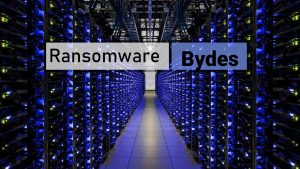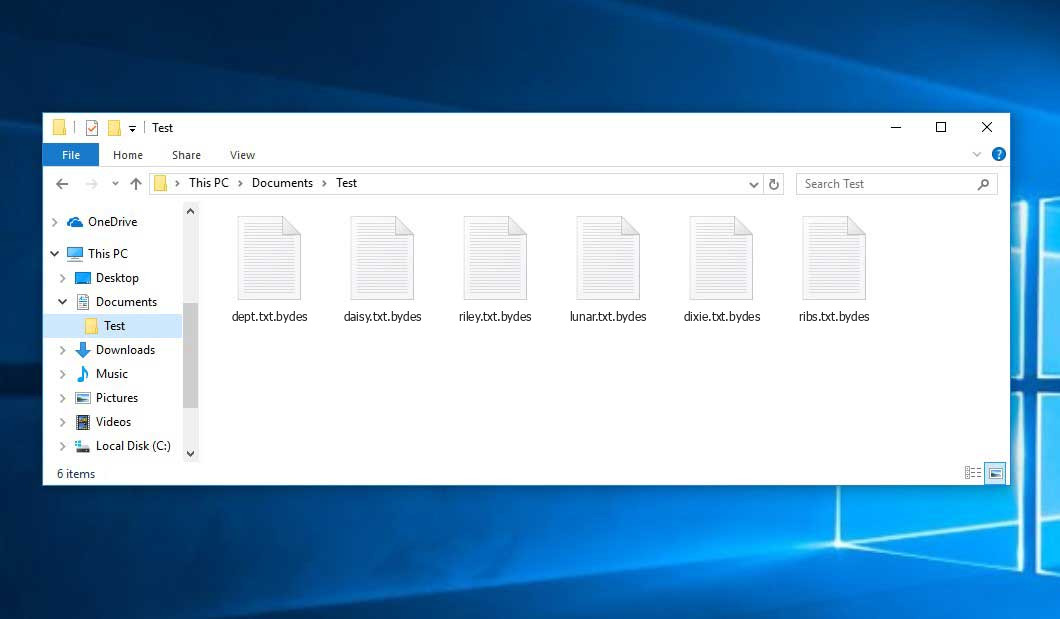The Bydes virus falls under the ransomware type of malicious agent. Harmful software of such sort encrypts all the data on your computer (images, text files, excel sheets, music, videos, etc) and adds its extra extension to every file, and shows the pop-up window when the ciphering is over.
What is Bydes virus?
☝️ A scientifically accurate denomination for the Bydes would be “a ransomware-type malicious agent”.
Bydes adds its specific .bydes extension to the title of every encrypted file. For instance, an image entitled “photo.jpg” will be changed to “photo.jpg.bydes”. Just like the Excel sheet with the name “table.xlsx” will be renamed to “table.xlsx.bydes”, and so on.
When ransomware ends the encryption process, it shows a pop-up window. It is a ransom money note. Therein you can find information about the ways of paying the ransom and some other information. The ransom note usually contains instructions on how to purchase the decryption tool from the tamperers. That is it.
Bydes summary:
| Name | Bydes Virus |
| Extension | .bydes |
| Ransomware note | Pop-up window |
| Detection | Ransom:Win32/Cryptolocker.PAL!MTB, UDS:Trojan-Banker.Win32.Bandra, Trojan:MSIL/AgentTesla.EPQ!MTB |
| Symptoms | Your files (photos, videos, documents) get a .bydes extension and you can’t open them. |
| Fix Tool | See If Your System Has Been Affected by Bydes virus |
In the picture below, you can see what a folder with files encrypted by the Bydes looks like. Each filename has the “.bydes” extension appended to it.
How did Bydes ransomware end up on my PC?
There are plenty of possible ways of ransomware injection.
Nowadays, there are three most exploited ways for tamperers to have the Bydes virus planted in your digital environment. These are email spam, Trojan injection and peer-to-peer file transfer.
If you access your inbox and see letters that look like familiar notifications from utility services providers, delivery agencies like FedEx, web-access providers, and whatnot, but whose addresser is strange to you, beware of opening those emails. They are most likely to have a malware item enclosed in them. Thus it is even riskier to open any attachments that come with letters like these.
Another option for ransom hunters is a Trojan virus model1. A Trojan is a program that gets into your PC disguised as something legal. For instance, you download an installer for some program you want or an update for some service. But what is unpacked turns out to be a harmful agent that encrypts your data. As the update file can have any title and any icon, you’d better be sure that you can trust the resource of the stuff you’re downloading. The optimal way is to use the software companies’ official websites.
As for the peer networks like torrents or eMule, the threat is that they are even more trust-based than the rest of the Web. You can never guess what you download until you get it. So you’d better be using trustworthy websites. Also, it is a good idea to scan the directory containing the downloaded objects with the anti-malware utility as soon as the downloading is finished.
How to remove the Bydes virus?
It is crucial to inform you that besides encrypting your files, the Bydes virus will most likely install the Azorult Spyware on your computer to seize your credentials to various accounts (including cryptocurrency wallets). That program can extract your logins and passwords from your browser’s auto-filling cardfile.
Often tamperers would decrypt some of your files so you know that they really have the decryption program. Since Bydes virus is a relatively recent ransomware, anti-malware designers have not yet found a method to reverse its work. However, the decryption instruments are frequently updated, so the solution may soon arrive.
Sure thing, if the criminals do the job of encrypting victim’s critical files, the desperate person will probably comply with their demands. However, paying to criminals gives no guarantee that you’re getting your data back. It is still risky. After obtaining the ransom, the racketeers may deliver a wrong decryption key to the victim. There were reports about hackers simply disappearing after getting the ransom without even writing back.
The optimal safety measure against ransomware is to have aan OS restore point or the copies of your essential files in the cloud storage or at least on an external disk. Obviously, that might be insufficient. Your most crucial thing could be that file you were working upon when it all happened. Nevertheless, it is something. It is also reasonable to scan your PC for viruses with the anti-malware utility after the OS restoration.
Bydes is not the only ransomware of its kind, since there are other specimens of ransomware out there that act in the same manner. For instance, Jhgn, Sijr, Hhjk, and some others. The two main differences between them and the Bydes are the ransom amount and the method of encryption. The rest is almost identical: documents become inaccessible, their extensions changed, ransom notes are created in every folder containing encoded files.
Some fortunate victims were able to decode the blocked files with the aid of the free tools provided by anti-ransomware developers. Sometimes the criminals mistakenly send the decoding key to the victims in the ransom readme. Such an epic fail allows the user to restore the files. But of course, one should never rely on such a chance. Make no mistake, ransomware is a tamperers’ technology to pull the money out of their victims.
How to avoid ransomware injection?
Bydes ransomware has no endless power, so as any similar malware.
You can armour yourself from its attack taking three easy steps:
- Ignore any letters from unknown mailers with unknown addresses, or with content that has nothing to do with something you are waiting for (can you win in a lottery without participating in it?). If the email subject is more or less something you are expecting, scrutinize all elements of the dubious email with caution. A fake letter will surely contain mistakes.
- Never use cracked or unknown software. Trojan viruses are often spreaded as an element of cracked software, most likely as a “patch” preventing the license check. Understandably, potentially dangerous programs are difficult to distinguish from reliable software, because trojans may also have the functionality you need. You can try to find information on this program on the anti-malware forums, but the best way is not to use such software.
- And to be sure about the safety of the objects you downloaded, scan them with GridinSoft Anti-Malware. This program will be a powerful defense for your system.
Reasons why I would recommend GridinSoft2
There is no better way to recognize, remove and prevent ransomware than to use an anti-malware software from GridinSoft3.
Download Removal Tool.
You can download GridinSoft Anti-Malware by clicking the button below:
Run the setup file.
When setup file has finished downloading, double-click on the setup-antimalware-fix.exe file to install GridinSoft Anti-Malware on your computer.

An User Account Control asking you about to allow GridinSoft Anti-Malware to make changes to your device. So, you should click “Yes” to continue with the installation.

Press “Install” button.

Once installed, Anti-Malware will automatically run.

Wait for the Anti-Malware scan to complete.
GridinSoft Anti-Malware will automatically start scanning your system for Bydes infections and other malicious programs. This process can take a 20-30 minutes, so I suggest you periodically check on the status of the scan process.

Click on “Clean Now”.
When the scan has finished, you will see the list of infections that GridinSoft Anti-Malware has detected. To remove them click on the “Clean Now” button in right corner.

Frequently Asked Questions
🤔 How can I open “.bydes” files?Is it possible to open“.bydes” files?
There’s no way to do it, unless the files “.bydes” files are decrypted.
🤔 I really need to decrypt those “.bydes” files ASAP. How can I do that?
If the “.bydes” files contain some really important information, then you probably have them backed up. Otherwise, you might try to employ System Restore. The only question is whether you have saved any Restore Points that would be helpful now. There are other ways to beat ransomware, but they take time.
🤔 Will GridinSoft Anti-Malware remove all the encrypted files alongside the Bydes virus?
Absolutely not! Your encrypted files are no threat to your PC.
With the help of GridinSoft Anti-Malware, you can clean your computer off the actual threats. The ransomware that has attacked your PC is must be still active and it scans your system every so often to encrypt any new files you might create on your computer after the attack. As it has been said above, the Bydes ransomware does not come alone. It installs backdoors and keyloggers that can take your account passwords by trespass and provide hackers with easy access to your PC after some time.
🤔 What to do if the Bydes malware has blocked my PC and I can’t get the activation code.
In such a case, you need to prepare a memory stick with a previously installed Trojan Killer. Use Safe Mode to execute the procedure. You see, the ransomware runs automatically as the system boots and encodes any new files created or brought into your system. To block this process – use Safe Mode, which allows only the essential applications to run automatically. Consider reading our manual on running Windows in Safe Mode.
🤔 And what should I do now?
Many of the encoded files might still be within your reach
- If you sent or received your important files by email, you could still download them from your online mailbox.
- You might have shared images or videos with your friends or family members. Simply ask them to post those pictures back to you.
- If you have initially got any of your files from the Web, you can try doing it again.
- Your messengers, social networks pages, and cloud disks might have all those files too.
- It might be that you still have the needed files on your old PC, a portable device, cellphone, memory stick, etc.
HINT: You can use data recovery utilities4 to retrieve your lost information since ransomware encrypts the copies of your files, removing the original ones. In the video below, you can learn how to recover your files with PhotoRec, but be advised: you can do it only after you kill the ransomware itself with an antivirus program.
Also, you can contact the following governmental fraud and scam sites to report this attack:
- In the United States: On Guard Online;
- In Canada: Canadian Anti-Fraud Centre;
- In the United Kingdom: Action Fraud;
- In Australia: SCAMwatch;
- In New Zealand: Consumer Affairs Scams;
- In France: Agence nationale de la sécurité des systèmes d’information;
- In Germany: Bundesamt für Sicherheit in der Informationstechnik;
- In Ireland: An Garda Síochána;
To report the attack, you can contact local executive boards. For instance, if you live in USA, you can have a talk with FBI Local field office, IC3 or Secret Service.
I need your help to share this article.
It is your turn to help other people. I have written this guide to help users like you. You can use the buttons below to share this on your favorite social media Facebook, Twitter, or Reddit.
Brendan SmithHow to Remove BYDES Ransomware & Recover PC

Name: BYDES Virus
Description: BYDES Virus is a ransomware-type infections. This virus encrypts important personal files (video, photos, documents). The encrypted files can be tracked by a specific .bydes extension. So, you can't use them at all.
Operating System: Windows
Application Category: Virus
User Review
( votes)References
- You can read more on Trojans, their use and types in the Trojan-dedicated section of GridinSoft official website.
- GridinSoft Anti-Malware Review from HowToFix site: https://howtofix.guide/gridinsoft-anti-malware/
- More information about GridinSoft products: https://gridinsoft.com/comparison
- Here are Top 10 Data Recovery Software Of 2023.


